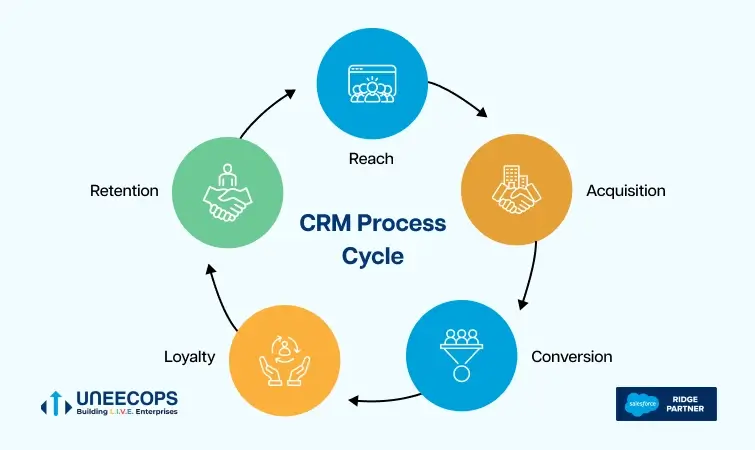Yes, we’re big fans of Salesforce. We love how powerful and nimble it is. Its flexible capabilities have allowed us to help enterprises build their own product therefore helped our customers generate more revenue from their existing sales resources. We love how Salesforce is completely transforming the way businesses are running – by automating tedious tasks, providing a complete view of the customers and accelerating productivity for the workforce. However, if salesforce implementation process is not done in a proper way, it may become the reason of project fail.
Yes, when done right, Salesforce has all the tools we need to help our business grow.
Still, tales of inexistent ROI, poor user adoption and frustrating limitations are ripe amongst many of its users. Even with so much investment destined to securing a good implementation, why do some companies succeed whilst others fall flat on their faces?
As the adoption of Salesforce grows, so does the rate of its implementation failure. Implementing a Salesforce project is a significant undertaking which can potentially provide you massive payoffs if you get it right. But, as no two implementations are the same, it is critical to consider all the different aspects that come with each Salesforce Implementation. It plays a crucial role in determining the probability of success or failure for the project.
Salesforce projects can go wrong for multiple reasons, and the solutions to fix them are dependent on the respective issues encountered. However, some common areas where Salesforce projects can go wrong and possible solutions are:
- Scope Creep
It is crucial to identify business requirements with immense clarity early in order to have successful implementations. One of the most significant causes of Salesforce projects going wrong is having ambiguous goals. Knowing the scope of your project even before you begin with it helps you to ensure a seamless and successful implementation.
Often, companies end up starting with a minimal set of goals and keep adding new requirements through the process. This topples the implementation and blows up your budget while disturbing the project timelines as well.
Your goals and objectives must be:
- Quantifiable
- Time-Bound
- Reflective of User Needs
Map out your requirements or objectives completely in the beginning and stick to them till the end. Ensure that expectations are only based on these objectives, clearly define requirements, and ensure proper management of these goals in order to limit the scope creep.
- Incompatible Implementation Partnerships
Salesforce projects and implementations are widely appealing to a variety of industries, keeping in mind the comprehensive features and extensive customizability it offers. Engaging with a similar partner who has experience of the same business gives your implementation a huge chance of success. However, finding the right partner is critical for this.
Often, businesses experience first-hand damages of incompatible partnerships for their Salesforce implementations. It has to be the right consultancy that knows Salesforce and is led by business smarts of your niche in order to be the right fit.
To avoid incompatible partnerships, you must:
- Keep your niche in mind
- Look for someone with industry experience
- Get an idea of how the project is going to be executed and ask for case studies of their previous conquests related to it
- Look for validation of the potential partner’s industry expertise
- Contact past clients and look at the partner’s certifications to size up their skills in your field of business
You must always choose a partner that has a history of working in your field. Such rich experience within your niche can help you avoid falling prey to the damages of incompatible partnerships.
- Prioritizing Technology Over People
Salesforce implementations have never been about just technology. So, when a business prioritizes technology or its products over the people using them, it paves the way to a sureshot downfall of their project.
End users are at the heart of every business. All goals, objectives, and requirements are set while keeping them in mind, which is why it is critical to keep them as the main focus in order to have successful Salesforce projects. You must:
- Make customers and employees the main focus rather than the technology
- Keep both customers and employees informed of all changes
- Allow them to give valuable feedback
- Use feedback coming from both employees and customers to improve your project
- Design plans and processes to support and facilitate better user experiences.
Putting people at the center and not prioritizing technology over people is essential to ensure successful Salesforce projects.
- Inconsistent or Inaccurate Data
Salesforce projects can also fail due to fundamental data problems, such as data being incomplete, irrelevant, duplicative, or inaccurate. It could lead to a myriad of problems, such as:
- Poor customer experiences
- Distrust
- Unwarranted business strategies
- Incorrect budget and revenue forecasts
Salesforce’s technology cannot help you if you fill it with poor data. Data is the ultimate foundation on which Salesforce instances are built, so the quality of data that you use will have a significant impact on the rest of the project. Ensure that you fill the system with precise and updated information, and if you don’t have such quality data, invest in data cleansing. Data cleansing can be a long and cumbersome task based on the amount of data your company generates, but it is a crucial step to identify your leads and then turn them into valuable customers.
Ensure deep cleaning of your data before implementing the Salesforce project. Salesforce offers easy ways to clearly define new objects and fields. However, you must ensure to collect data in a way that avoids long data input forms, poor user adoption, bad reporting, and inability to scale. This can be done by keeping the data entry process as simple as possible.
- Poor Communication Due to Silos
Organizational silos is a problematic element that contributes toward Salesforce projects going wrong. Businesses tend to keep their implementation teams isolated from stakeholders and other groups, which leads to poor communication and troublesome outcomes.
It is necessary to keep communication lines open for discussion with end users and other stakeholders at every stage of the process. It allows your implementation teams to receive first-hand feedback about the requirements from the people who are ultimately going to adopt and use the solution.
Ensuring efficient communication and avoiding silos can help you to ensure a successful Salesforce implementation.
- Lack of User Adoption
Users must be willing to adopt Salesforce and must be skilled enough to make the best use of it. User adoption is just as necessary as clean data to ensure Salesforce implementation success.
Lack of user adoption can be extremely harmful to your Salesforce implementation. Hence, it is crucial to invest significantly in training or engagement efforts for end users. Business leaders can appoint members of staff who can help others get up to speed, and use several other techniques to boost user adoption, such as:
- Training users well, providing them good training by regularly checking in on their learning and offering them continuously ongoing training
- Supporting users who are learning and getting feedback
- Allocating a budget for user training
- Implementing the concept of “Power Users” who are people within your organization who will love using Salesforce, learn quickly, and then help others
- Incentivize user adoption with gamification, success measurements, etc
- Show the benefits of increased productivity to users with the help of your Salesforce implementation
- Design a clear and realistic rollout strategy
- Onboard employees and users in stages and make sure that they are trained properly moving on to the next
How to Fix your Salesforce Project?
Here are a few ways you can fix or recover your Salesforce projects in case the implementation goes wrong:
1.Choosing Implementation Partners Wisely
Salesforce implementation failures are very common, which is why there are partners that solely specialize in recovering failed projects and help businesses ensure successful projects further. If your Salesforce project has gone wrong, looking for a right Rescue Implementation Partner is the safest option that you can take.
It is essential that you work with partners that share your values, business objectives and resonates to your brand story. Partnerships can be severely affected when there are conflicts or communication breakdowns between partners and the sales team. In such cases, always opt for Rescue Implementation Partners who hold niche in handling critical projects. Such partners do their detailed prognosis before even actually providing started working on it.
2. Retrain Users
User resistance is a crucial indicator of the failure of a Salesforce implementation. It can be possible due to a number of reasons, most of which can be solved by educating them again.
Ask users for feedback and train them effectively with the resources that they are comfortable with in order to ensure effective training. In case of budget or time constraints, self-service resources or self-training programs can also be executed or rolled out to retrain users.
3. Quality Data Practices
Good data practices are essential for successful Salesforce projects. A significant reason behind the failure of the implementation can be bad data, which must be rectified by cleaning it properly and bringing it up to the quality level required.
However, good data practices must be encouraged from the beginning:
- Audit your data regularly
- Ensure that it is as comprehensive as possible
- Make sure that your data adheres to the business’ data labeling and formatting procedures
- Assign data to the correct fields
Some Other Ways to Ensure Successful Salesforce Implementation and Projects are
- Setting SMART goals
- Setting realistic budgets
- Establishing clear strategies for implementations
- Arranging strong executive support
- Hiring an experienced support team
- Involve end users from the very beginning
- Aligning your new Salesforce project integration with the existing IT architecture
Conclusion
Although the reasons why Salesforce projects go wrong are not limited to the ones mentioned in this article, we have covered a wide range of causes to help you understand the variegated causes of a Salesforce project’s failure. Some other issues to address are a lack of plan, a lack of commitment, and a lack of buy-in. Every customer-driven business must address all these issues to ensure successful CRM or Salesforce implementations.
We have also discussed several ways to fix or recover failed Salesforce projects, but the ultimate key to it will always be identifying the root cause first and then proceeding to implement the targeted solution for it.
When hiring Salesforce Implementation Partners, you need someone who themselves would be able to identify what’s missing in your business process and fill those gaps with Salesforce Implementation.
Sometimes, things might not turn out well even with the most experienced partners. Having said that, it is imperative to opt for Salesforce Rescue Implementation Partners who take up your sinking projects exactly from where you are facing trouble. Making such decisions would save you from the trouble to analyze and find out the loopholes of your business. These certified professionals would do it all.
Does any of the above-mentioned reasons, you think is taking your Salesforce Projects down? Or would you like to know more about our Salesforce Solutions?
Contact us today to set up a hassle-free consultation on you failed projects or for new ones too. We can help you arranging a callback with our Solutions Expert who can create a well-structure Salesforce Implementation Roadmap and assist you in solving setbacks in your SFDC projects if any.







